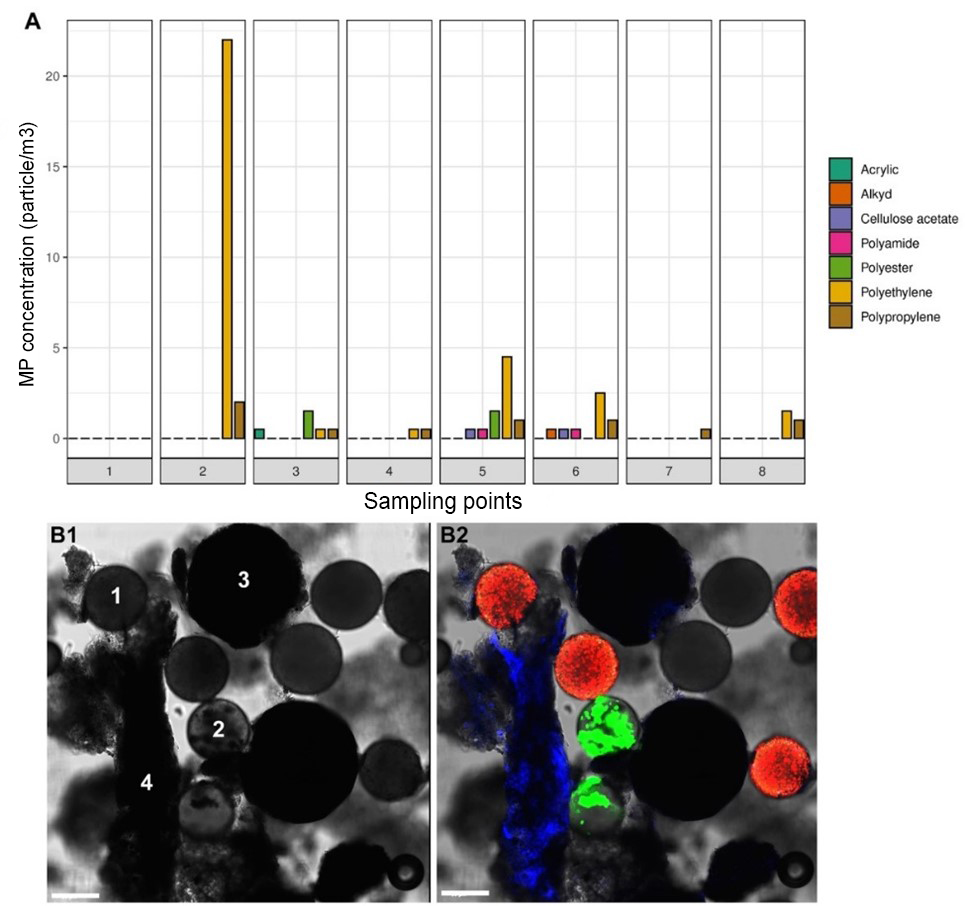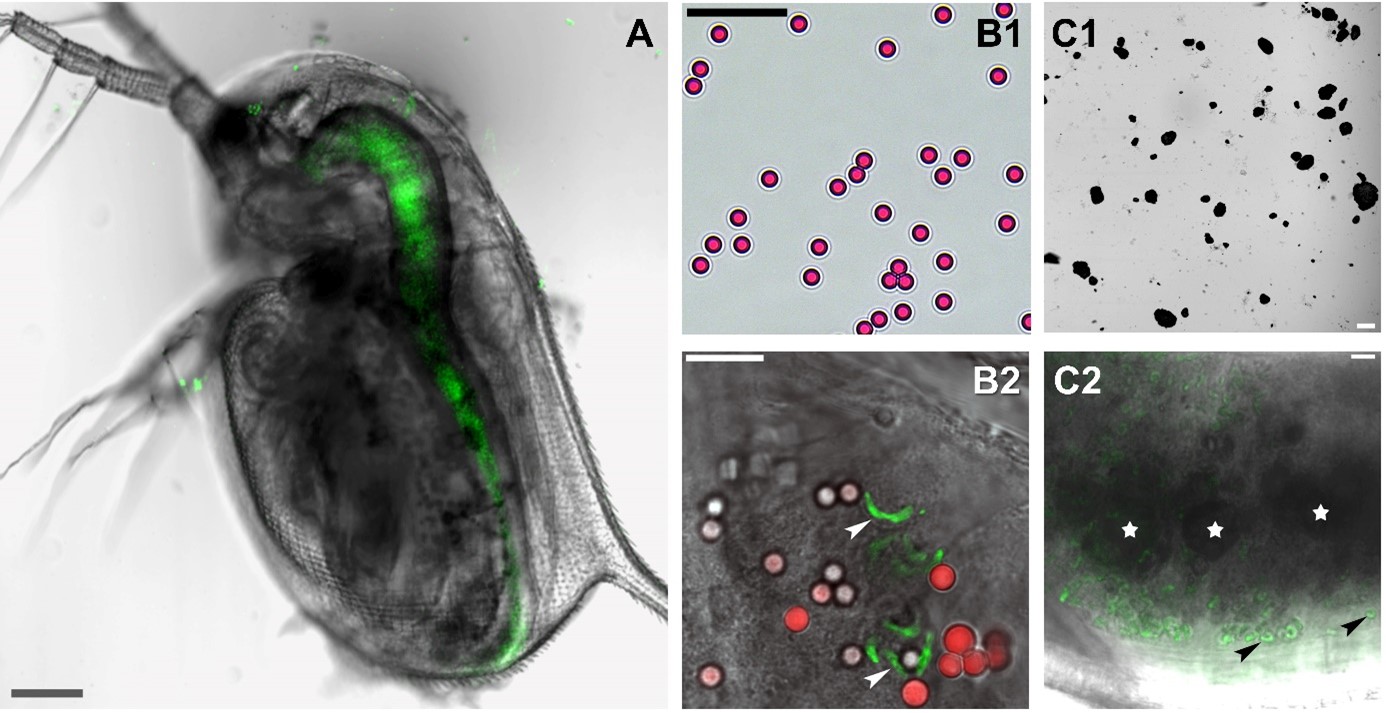Researchers from the ELKH Balaton Limnological Research Institute (BLKI) regularly examine anthropogenic pollutants and their impact on the water ecosystem in Lake Balaton and its catchment area. Their new study, part of a project carried out in collaboration with experts from the Hungarian University of Agriculture and Life Sciences (MATE) and Eurofins Analytical Services Hungary Kft., sought to find out if it was possible to identify microplastic particles in the lake, and, if so, what ecological risk these particles might pose to the water ecosystem. First, the researchers confirmed that there were different types of 50-100 µm-sized microplastic particles present in the various basins of the lake. In addition, by examining a classic ecotoxicological model animal, the water flea (Daphnia magna), they were able to establish the physiological effects of microplastic particles on invertebrates, both alone and in combination with other anthropogenic chemical pollutants (e.g., pharmaceutical residues) that can also be measured in the Lake Balaton. The researchers have published a paper about the results in the prestigious international journal Science of the Total Environment.
In recent years, there has been increasing cause for concern on a global level about the presence of microplastic pollutants in nature. International studies have largely focused on marine ecosystems. As a result, there have been fewer scientific publications to date regarding the presence of these materials in freshwater. It is known that microplastic particles can cause acute and chronic effects on algae, as well as in various invertebrate and vertebrate species. It is also known that these particles have a high binding capacity for hydrophobic contaminants – such as various pharmaceutical residues or polycyclic aromatic hydrocarbons – on their surface, something that can enhance the toxic effects of anthropogenic chemicals and also contribute to their bioaccumulation and biomagnification in living organisms.
In recent years, the BLKI Ecophysiological and Environmental Toxicological Research Group, led by Dr Zsolt Pirger, has described in several articles the presence of anthropogenic pharmaceutical residues in Lake Balaton and its catchment area, as well as their spatial and temporal distribution (Avar et al., 2016a, 2016b; Maasz et al., 2019; Molnar et al., 2021). The research group has also described the concentration of pollutants – which is generally measured between a few tens of ng/L and 1-2 µg/L – can be considered average compared to the global data. Based on the environmental risk assessments of the detected concentrations (Molnár et al. 2021b), the researchers considered that chronic impact studies were needed for several compounds at an individual, cellular and molecular level using invertebrate and vertebrate models of the Balaton ecosystem (Maasz et al., 2017; Zrinyi et al., 2017; Svigruha et al., 2021a, 2021b). However, these types of environmental measurements and ecotoxicological studies carried out under controlled laboratory conditions had not yet been completed for microplastic particles detected in Lake Balaton.
Researchers from the MATE Institute of Aquaculture and Environmental Safety and staff from Eurofins Analytical Services Hungary Kft. measured eight sampling points using their self-developed filtering system, the details of which were published previously (Bordos et al., 2021; Mari et al., 2021), where they identified the number of various types and sizes of microplastic particles in 1,000 liters (1 m3) of water. The researchers identified seven types of polymers in the 50-100 µm size range, with polypropylene and polyethylene particles being the most common – in line with global trends. In this size range, independently of the polymer type, the average number of particles was 5.5 per 1,000 litres, which is similar to values measured in various other European lakes (0-7.3 particles/1,000 liters; 45 - 780 μm; based on an analysis of 67 lakes; Tanentzap et al., 2021).


Figure 1: Process for identifying microplastic particles (MP) (sampling, filtering, multiple types of detection, e.g., laser confocal microscopy); A: distribution of MP particles by type at each sampling point, B: microscopic image of different types of MPs in transmitted light detector (B1) and fluorescence filters (B2).

Figure 2: MP particles in the digestive tract of filter-feeding D. magna. A: Laser confocal microscope images of algal cells (green colour) in the digestive tract of control D. magna. B1: A representative white light microscopic image about the red-coloured 3-5 µm polyethylene particles. B2: A confocal microscopic image about the red-coloured 3-5 µm polyethylene granules presence in the D. magna digestive tract together with green-coloured algae (arrowhead). C1: A representative white light microscopic image of polystyrene particles with diameters smaller than 100 µm and of various sizes. C2: polystyrene granules of 20-30 µm in diameter (asterisks) in the D. magna digestive tract together with green-coloured algae (arrowhead).
During investigations, the researchers observed several changes in the growth and reproduction of the water fleas, as well as in the activity of their biomarkers, and confirmed that the microplastic particles and progestogens, both separately and in combination, cause behavioural and biochemical changes in D. magna specimens. At the same time, they also emphasized that, contrary to expectations, the combined effects were negligible. The results offer an indication of the potential ecological impacts of environments disturbed by humans.